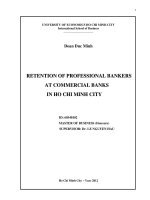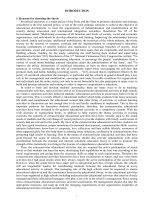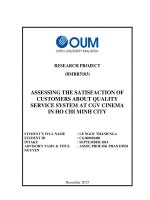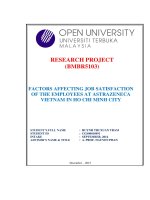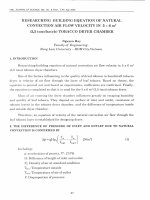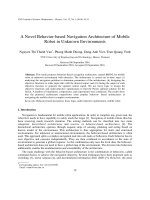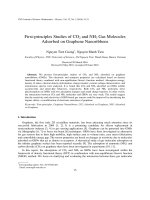DSpace at VNU: Self-reported oral health, oral hygiene, and oral HPV infection in at-risk women in Ho Chi Minh City, Vietnam
Bạn đang xem bản rút gọn của tài liệu. Xem và tải ngay bản đầy đủ của tài liệu tại đây (426.73 KB, 29 trang )
Accepted Manuscript
Self-reported Oral Health, Oral Hygiene, and Oral HPV Infection in At-Risk Women in
Ho Chi Minh City, Vietnam
Thanh Cong Bui, Dr.P.H., Ly Thi-Hai Tran, Ph.D., Christine M. Markham, Ph.D.,
Thuy Thi-Thu Huynh, M.D., Ph.D., Loi Thi Tran, M.D., Ph.D., Vy Thi-Tuong Pham,
M.D., Quan Minh Tran, Ngoc Hieu Hoang, M.D., Lu-Yu Hwang, M.D., Erich Madison
Sturgis, M.D., M.P.H.
PII:
S2212-4403(15)00619-7
DOI:
10.1016/j.oooo.2015.04.004
Reference:
OOOO 1180
To appear in:
Oral Surgery, Oral Medicine, Oral Pathology and Oral
Radiology
Received Date: 3 December 2014
Revised Date:
8 April 2015
Accepted Date: 10 April 2015
Please cite this article as: Cong Bui T, Tran LT-H, Markham CM, Huynh TT-T, Tran LT, Pham VT-T,
Tran QM, Hoang NH, Hwang L-Y, Sturgis EM, Self-reported Oral Health, Oral Hygiene, and Oral HPV
Infection in At-Risk Women in Ho Chi Minh City, Vietnam, Oral Surgery, Oral Medicine, Oral Pathology
and Oral Radiology (2015), doi: 10.1016/j.oooo.2015.04.004.
This is a PDF file of an unedited manuscript that has been accepted for publication. As a service to
our customers we are providing this early version of the manuscript. The manuscript will undergo
copyediting, typesetting, and review of the resulting proof before it is published in its final form. Please
note that during the production process errors may be discovered which could affect the content, and all
legal disclaimers that apply to the journal pertain.
ACCEPTED MANUSCRIPT
Title: Self-reported Oral Health, Oral Hygiene, and Oral HPV Infection in At-Risk Women in
Ho Chi Minh City, Vietnam
Suggested running head: Oral Health, Oral Hygiene, and Oral HPV Infection
RI
PT
Authors: Thanh Cong Bui1, Dr.P.H.; Ly Thi-Hai Tran2, Ph.D., Christine M. Markham3, Ph.D.;
Thuy Thi-Thu Huynh4, M.D., Ph.D.; Loi Thi Tran5, M.D., Ph.D.; Vy Thi-Tuong Pham6, M.D.;
M.D., M.P.H.
1
Department of Behavioral Science, The University of Texas MD Anderson Cancer Center,
M
AN
U
Houston, Texas, United States of America.
2
SC
Quan Minh Tran6; Ngoc Hieu Hoang7, M.D.; Lu-Yu Hwang2, M.D.; and Erich Madison Sturgis8,
Department of Epidemiology, School of Public Health, The University of Texas Health Science
Center at Houston, Houston, Texas, United States of America.
3
Department of Health Promotion and Behavioral Sciences, School of Public Health, The
TE
D
University of Texas Health Science Center at Houston, Houston, Texas, United States of
America.
Tu Du Hospital of Obstetrics and Gynecology, Ho Chi Minh City, Vietnam.
5
Department of Obstetrics and Gynecology, Faculty of Medicine, Vietnam National University
EP
4
in Ho Chi Minh City, Ho Chi Minh City, Vietnam.
Pham Ngoc Thach University of Medicine, Ho Chi Minh City, Vietnam.
7
Biochemistry Department, University of Mississippi Medical Center, Jackson, Mississippi,
AC
C
6
United States of America.
8
Department of Head and Neck Surgery, Division of Surgery, The University of Texas MD
Anderson Cancer Center, Houston, Texas, United States of America.
i
ACCEPTED MANUSCRIPT
Corresponding author:
THANH CONG BUI
Department of Behavioral Science,
The University of Texas MD Anderson Cancer Center
,
M
AN
U
T: 713-745-5542, F: 713-745-4286
SC
P.O. Box 301439, Houston, Texas 77230-1439, USA
RI
PT
Instructor
Financial support: This study was supported by the University of Texas Health Science Center
at Houston, School of Public Health, Center for International Training on AIDS Research
(externally funded by National Institutes of Health - Fogarty International Center, AIDS
TE
D
International Training and Research Program, D43 TW007669), and by the Margaret McNamara
Memorial Fund. Thanh C. Bui was supported by the UTHealth Innovation for Cancer Prevention
Research post-doctoral fellowship, Cancer Prevention and Research Institute of Texas (CPRIT)
EP
grant #RP101503, and is supported by a faculty fellowship from The University of Texas
MD Anderson Cancer Center Duncan Family Institute for Cancer Prevention and Risk
AC
C
Assessment. Ly T. Tran’s education was supported by the Vietnam Education Foundation
Fellowship, Philanthropic Educational Organization International Peace Scholarship, and
American Association of University Woman. The content of the manuscript is solely the
responsibility of the authors and does not necessarily represent the official views of the funding
agencies.
ii
ACCEPTED MANUSCRIPT
Conflict of Interest Disclosures: The authors declared no potential conflicts of interest relevant
to this study.
RI
PT
Author contributions: Study design: Bui, Ly Tran, Loi Tran, Huynh. Data collection: Bui, Ly
Tran, Pham, Quan Tran, Loi Tran, Huynh. Analysis and interpretation of data: Bui, Ly Tran,
Markham, Hwang, Sturgis. Writing, review, and/or revision of the manuscript: Bui, Ly Tran,
SC
Markham, Loi Tran, Huynh, Hwang, Sturgis. HPV testing: Hoang. Administrative, technical, or
material support: Markham, Loi Tran, Huynh, Hwang. Bui had full access to all of the data in
analysis.
M
AN
U
the study and takes responsibility for the integrity of the data and the accuracy of the data
Prior or upcoming presentation of abstracts at meetings regarding the study: None.
TE
D
Abstract Word Count: 200.
Manuscript Word Count: 3518.
Number of tables: 2.
EP
Number of figures: 0.
Number of references: 29.
AC
C
Number of supplementary elements: 0.
iii
ACCEPTED MANUSCRIPT
ABSTRACT
Objectives: This study aimed to examine the relationship between self-reported oral health, oral
hygiene practices, and oral human papillomavirus (HPV) infection among women at risk for
RI
PT
sexually transmitted infections in Ho Chi Minh City, Vietnam. Study design: Convenience and
referral sampling methods were used in a clinic-based setting to recruit 126 women aged 18–45
years between August–October 2013. Behavioral factors were self-reported. Oral-rinse samples
SC
were tested for HPV DNA of two low-risk and 13 high-risk genotypes. Results: A higher
unadjusted prevalence of oral HPV infection was associated with poorer self-rated overall oral
M
AN
U
health (p=.001), reporting oral lesions/problems in the past year (p=.001), and reporting a tooth
loss not because of injury (p=.001). Higher unadjusted prevalence of oral HPV infection was also
associated with two measures of oral hygiene: lower frequencies of toothbrush per day (p=.047)
and gargling without toothbrush (p=.037). After adjusting for other factors in multivariable
TE
D
logistic regression models, poorer self-rated overall oral health remained statistically associated
with oral HPV infection (p=.042); yet, the frequency of toothbrush per day did not (p=.704).
Conclusion: Results corroborate the association between self-reported poor oral health and oral
EP
HPV infection. The effect of oral hygiene on oral HPV infection remains inconclusive.
AC
C
Key words: oral HPV infection, oral health, oral hygiene, oral sex, oropharyngeal neoplasms,
oral cancer, head and neck cancer.
1
ACCEPTED MANUSCRIPT
INTRODUCTION
Research has shown that oral infection with high-risk (i.e. oncogenic) types of human
papillomavirus (HPV) is etiologically associated with oropharyngeal squamous cell carcinoma.1-3
RI
PT
In a systematic review, oral HPV was also associated with potentially malignant disorders, such
as leukoplakia, oral lichen planus, or epithelial dysplasia.4 The prevalence of oral HPV infection
ranges from 1.3–9.2% in the general population,5-9 and is 2-3 times higher in HIV-positive
SC
populations.10-13 HPV 16 is often the most common type identified.5, 6 Risk factors for oral HPV
infection which have been consistently identified in several studies include cigarette smoking,
M
AN
U
number of lifetime sex partners, and performing oral sex behaviors.2, 3, 5, 6, 13-16 Other less
consistently found risk factors are age, biological sex, alcohol consumption, and open-mouth
kissing.
Both oral health and oral hygiene have been associated with oral and oropharyngeal
TE
D
cancers.3 An increased risk of these cancers is associated with indicators of poor oral health (e.g.
tooth loss, irregular dental check-ups),3 and with indicators of poor oral hygiene (e.g. less
frequent tooth brushing, having visible plaque, having dental caries).3, 17, 18 Using a sample of
EP
3,439 participants aged 30–69 years from the 2009–2010 National Health and Nutrition
Examination Survey in the United States, our previous study showed that poor oral health also
AC
C
elevated the odds of oral HPV infection, independent of smoking status and oral sexual
behaviors.19 Through epithelial wounds in the oral cavity, HPV enters the basal layer of
epithelium to establish the infection.20 Poor oral health, which may include ulcers, mucosal
disruption, or chronic inflammation, may create an entry portal for HPV or may increase the
epithelium’s susceptibility to HPV.
The relationship between oral hygiene and oral HPV infection remainsrelatively
unexplored. Hypothetically, because oral hygiene is fundamental to improve oral health,
2
ACCEPTED MANUSCRIPT
maintaining good oral hygiene practices may reduce oral health problems and thus may have a
protective effect against oral HPV infection. To our knowledge, only one cohort study of 212
male university students (18-24 years old) examined this relationship; and it found a non-
RI
PT
significant association between frequency of tooth brushing per week and oral HPV incidence.8
However, only one indicator of oral hygiene (i.e. tooth brushing) was measured in this study.
Another possible mechanism for the relationship between oral hygiene and oral HPV infection is
SC
the physical effect of oral rinse in removing HPV or exfoliated cells that contain HPV after
exposure. This proposition is supported by the thought that the continuous flow of saliva
M
AN
U
possibly contributes to a commonly lower HPV prevalence and incidence in the oral region,
compared with anogenital sites.9 If this physical effect is real, using oral rinse shortly after
performing oral sex may help wash away HPV DNA or exfoliated cells which contain HPV
DNA at the point of exposure, and may reduce subsequent oral HPV infection. This effect is
TE
D
particularly more observable in high-risk populations who have several oral sex partners.
This study aimed to examine the relationship between self-reported oral health, selfreported oral hygiene practices, and oral HPV infection among women at risk for STIs in Ho Chi
EP
Minh City (HCMC), Vietnam. Results of this research are important for future interventions to
AC
C
prevent oncogenic HPV infection in the oral cavity.
MATERIALS AND METHODS
Study Population
Women at risk for sexually transmitted infections (STIs) were recruited from a clinic-
based cross-sectional study at two gynecology clinics at a national obstetrics/gynecology hospital
in HCMC. We employed convenience sampling to recruit all eligible women aged 18–45 years
3
ACCEPTED MANUSCRIPT
who came to these clinics between August–October 2013. Eligibility criteria, which defined
being at risk for STIs, included at least one of the following: (1) had ≥ 3 different lifetime sexual
partners, (2) had ≥ 2 different sexual partners in the past month, (3) was diagnosed with any STI
RI
PT
≥ 2 times or with ≥ 2 types, (including chlamydia, gonorrhea, syphilis, trichomoniasis,
granuloma inguinale, Herpes Simplex Virus, HPV, HIV, and Hepatitis B Virus; and including an
STI diagnosis at the time of recruitment), and (4) ever exchanged sex for money or other goods.
SC
Even in urban areas in Vietnam, like HCMC, it is uncommon for women in the general
population to have multiple sexual partners (e.g. mean lifetime number of sexual partners = 1.1,
M
AN
U
SD = .5),21 and to have premarital sex (e.g. about 2.6% in a national Survey Assessment of
Vietnamese Youth).22 All eligible women were invited to take part in the study; three refused to
participate due to time conflicts. We additionally employed a snow-ball sampling technique by
asking those participants who reported ever trading sex to refer other female sex workers in their
TE
D
network to participate in this study. The total sample size was 126. The study protocol was
approved by a local institutional review board (IRB) (QD/BVTD-2424) and the IRB of The
University of Texas Health Science Center at Houston (HSC-SPH-13-0297).
EP
Data collection
Prior to data collection, all participants went through an informed consent process and
AC
C
provided a written consent. Participants underwent a 45-minute face-to-face interview, and then
provided an oral rinse specimen for oral HPV testing. Interviewers were nurses and physicians
who were trained on how to conduct the interviews and on all related ethical issues. A structured
questionnaire, which had been pre-tested with a convenience sample of eight healthcare
professionals and 10 women in Vietnam, was used for the interviews. All interviews were
conducted in Vietnamese, in private clinic rooms. Each participant received the equivalent of $7
4
ACCEPTED MANUSCRIPT
US dollars in compensation for their time. After the interview, participants were instructed to
gargle with 10 mL of a common commercial mouthwash for 20 seconds, and then expectorated
the specimen into a sterile collection cup. Specimens were transported to the hospital’s
RI
PT
Biological & Genetic Testing Lab on a daily basis for HPV genotyping. The principal
investigators (TB and Ly T) directly supervised all data collection activities in the clinics.
Measures
SC
Primary independent variables included oral health and oral hygiene practices, collected
through self-report in the interviews. Oral health was measured by self-rated overall oral health
M
AN
U
on a 5-point Likert scale (poor, fair, so-so, very good, and excellent), number of times having
oral lesions/problems in the past year, and having a tooth lost not because of injury.23 Variables
measuring oral hygiene practices comprised the average number of times of toothbrushing per
day in the past year, frequency of gargling without toothbrushing in the past year (i.e., beside
TE
D
times of toothbrushing; from 1=never to 5=very often), and the average number of toothbrushing
or gargling shortly after performing oral sex (i.e. the woman’s mouth contacted male partner’s
genitals) per 10 occasions of performing oral sex in the past year. Because the distribution of this
EP
last variable was either very uncommon (0–3 times) or very common (8–10 times), with very
few cases in between, it was dichotomized as always brushing teeth or gargling after performing
AC
C
oral sex or not (yes=8–10 times vs. no) in this analysis. We additionally asked for the number of
hours since last tooth brushing or gargling in order to control for potential bias in HPV detection.
The primary dependent variable was oral infection with any HPV type(s) (see below). Covariates
included age, education level, cigarette smoking status, alcohol use, drug use, ever traded sex,
oral sex behaviors, frequency of using a protection (condom/dental dam) in oral sex, lifetime
number of vaginal/oral sex partners, and HIV status.
5
ACCEPTED MANUSCRIPT
HPV DNA Detection Technique
We used the automated Kingfisher system with DynaBead® (Invitrogen) and detergents
(Triton X100, Guadinin thiocyanate - Merck) to extract DNA from collected specimens. DNA-
RI
PT
binding beads were then washed by ethanol to remove contaminants. To screen for the existence
of HPV DNA, nested polymerase chain reaction (PCR) was used with consensus primers
designed on the L1 gene of the HPV DNA (MY09/M11 PCR). After amplification, PCR
SC
products were analyzed by electrophoresis on 2% agarose gels staining with GelRed (Biotium).
HPV-positive samples were then genotyped. Amplicons were hybridized onto ELISA plates
M
AN
U
which were coated with streptavidine and specific genotyped probes in each well (genotypes 6,
11, 16, 18, 31, 33, 35, 39, 45, 51, 52, 56, 58, 59, & 68). Genotype-specific probes bound to
complementary denatured amplicons. The resulting hybrids were detected by tetramethyl
benzidine coloring after incubation with horseradish-peroxidase -binding monoclonal antibody to
TE
D
digoxigenin. Finally, absorbance was read using the iMarkTM Microplate Reader (Biorad) at
450nm. The variable of oral HPV infection was coded as positive if any of the 2 low-risk (6 &
11) or 13 high-risk (the remaining in the above list) HPV DNA types were detected.
EP
Data analysis
Bivariate associations between demographic or behavioral variables and oral HPV
AC
C
infection were examined using chi-square tests or binary logistic regression. Due to small
numbers of cases responding to some values of self-rated overall oral health, responses to this
variable were recoded into three categories: poor-fair, so-so, and very good-excellent. Separate
multivariable logistic regression models were used to examine the adjusted associations between
primary independent variables (oral health and oral hygiene practices, respectively) and oral
HPV outcomes. A directed acyclic graph was used to select covariates to be controlled for in
6
ACCEPTED MANUSCRIPT
multivariable logistic regression models.24 A two-sided p-value of <.05 was considered
statistically significant.
RI
PT
RESULTS
In our sample, 95.2% were Kinh ethnicity, the major ethnicity in Vietnam. The mean age
of participants was 31.9 years (S.D.= 6.2; median= 32). About half of them had not attended high
SC
school (Table 1). Seventy-two percent had ever performed oral sex, and 37.3% reported ever
trading sex for money, drugs, or other in-kind exchange. The prevalence of those who currently
M
AN
U
smoked and ever used drugs was 16.7% and 13.0%, respectively; most of these were in the
subgroup reporting ever traded sex (all p values<.001, data not shown). The prevalence of HIVpositive participants was 6.3% (1.3% in those who never traded sex, and 14.9% in those who
ever traded sex, p=.009). The prevalence of self-rated overall oral health was 17.6% for poor or
TE
D
fair, 43.2% for so-so, and 39.2% for very good or excellent. The majority of participants (68.3%)
brushed their teeth on average >1-2 times per day in the past year; 11.9% brushed their teeth 1
time or less per day. In addition to toothbrushing, 22.2% participants reported that they gargled
EP
sometimes and 35.7% gargled often or very often. Among those who gargled without
toothbrushing (n=81), 75.3% used water only, 17.3% used water with salt, and the remaining
AC
C
(7.4%) used commercial mouthwash. Among those who had ever performed oral sex (n=91),
58.9% always brushing teeth or gargling after performing oral sex.
The overall prevalence of oral infection with any HPV type was 24.6% (31/126), and
with any high-risk HPV type (i.e. excluding 6 & 11) was 16.7% (21/126). In the subgroup of
those who ever traded sex, the prevalence of oral HPV infection was 48.9% for any type and
38.3% for high-risk types. Among those who had any-type oral HPV infection, one case was
7
ACCEPTED MANUSCRIPT
infected with two types and one case was infected with three types. Among those who had oral
infection with a high-risk type of HPV (n=21), the most common types were 52 (n=10, 47.6%),
58 (n=7, 33.3%), and 16 (n=3, 14.3%). No participant had prior HPV immunization.
RI
PT
Table 1 displays bivariate associations between any-type oral HPV infection and
participants’ characteristics. Higher prevalence of oral HPV infection was found in those who
currently smoked, drank alcohol in the past 90 days, ever used drugs, ever performed oral sex,
SC
first performed oral sex at a younger age, had a higher number of lifetime vaginal sex partners,
had a higher number of lifetime partners on whom participants performed oral sex, and ever
M
AN
U
traded sex. Among those who ever performed oral sex, 94.5% never used any protection; this
was not associated with oral HPV infection, which might be due to the small sample of those
who ever used protection. Higher prevalence of oral HPV infection was also associated with all
three measures of self-reported oral health, including self-rated poorer oral health (p=.001),
TE
D
having oral lesions/problems in the past year (p=.001), and having tooth loss not because of
injury (p=.001). Regarding oral hygiene practices, higher frequency of tooth brushing per day
(p=.047) and gargling without toothbrushing (p=.037) were associated with a lower risk of oral
EP
HPV infection in bivariate analysis. Always brushing teeth or gargling after performing oral sex
(p=.175) and time since last tooth brushing or gargling (p=.801) were not associated with oral
AC
C
HPV detection.
We built separate multivariable logistic regression models to further examine the
associations between self-reported oral health, oral hygiene, and oral HPV infection when
controlling for other factors (Table 2). Self-rated overall oral health (Model 1) was selected to
represent oral health in this report, as in our previous work,19 and average number of
toothbrushing per day in past year (Model 2) to represent oral hygiene. Oral hygiene and oral
8
ACCEPTED MANUSCRIPT
health were examined in separate models because oral health might be an intermediate between
oral hygiene and oral HPV infection. Based on a priori knowledge and directed acyclic graphs,
we controlled for ever traded sex, ever performed oral sex, and smoking status. Smoking was not
RI
PT
included in the Model 2 because it cannot be a cause of the primary independent variable of oral
hygiene. Lifetime numbers of oral/vaginal sexual partners were not included because these were
strongly related to and were a descendant of ever traded sex. Although frequency of
SC
toothbrushing per day in the past year was strongly associated with self-rated overall oral health
in bivariate analysis (p<.001, data not shown), results in the multivariable logistic regression
M
AN
U
models indicated that self-rated overall oral health (p=.042) but not frequency of toothbrushing
per day (p=.704) remained associated with oral HPV infection.
DISCUSSION
TE
D
To our knowledge, this study is the first to report on oral HPV infection and associated
risk factors in Vietnam. In this group of at-risk women in HCMC, our data showed that oral HPV
infection was common. About one-fourth were infected with at least one HPV type, and 16.7%
EP
were infected with one of the 13 high-risk types which could be detected by our testing
technique. These figures are slightly lower than the prevalence of oral HPV infection in other at-
AC
C
risk populations, such as in the United States (34.0%).11 However, in the subgroup of those who
ever traded sex, the prevalence of oral HPV infection doubled, mirroring the high prevalence of
genital HPV infection (from 42.5%-85.0%) in this specific group in Vietnam.25, 26
Risk factors for oral HPV infection in our sample were consistent with risk factors found
in previous studies, including smoking status, ever performed oral sex, first performed oral sex at
a younger age, lifetime number of vaginal sex partners, and lifetime number of oral sex
9
ACCEPTED MANUSCRIPT
partners.5, 11, 14 Most previous studies have documented a strong association between oral HPV
infection and HIV-positive status due to immunosuppression (e.g. see Beachler et al., 2012)11.
However, this association was not statistically significant in our sample, likely due to a very
RI
PT
limited number of HIV-positive cases. Given that oral high-risk HPV infection has been
established as a cause for a subset of oropharyngeal cancers, and that this infection was
significantly more prevalent in those who reported trading sex, interventions for sex-worker
SC
groups may be needed to prevent long-term burden of oropharyngeal cancers.
Our results showed that self-reported oral health measures, particularly self-rated overall
M
AN
U
oral health, were significantly associated with oral HPV infection. The association between selfrated overall oral health and oral HPV infection remained significant in the multivariable model,
after controlling for other known risk factors (e.g., performing oral sex, smoking). This suggests
that self-reported poor oral health is an independent risk factor for oral HPV infection, regardless
TE
D
of trading-sex status, performing oral sex, and smoking status. This finding is consistent with the
results from our previous work, which were the first to suggest the tie between oral health and
oral HPV infection, irrespective of smoking and performing oral sex.19
EP
Our study provides initial evidence regarding possible links between a variety of selfreported oral hygiene practices and oral HPV infection. As mentioned above, only one previous
AC
C
study examined and found a non-significant association between tooth brushing and oral HPV
infection in univariate analysis.8 Our results showed that lower frequency of tooth brushing or
gargling without toothbrushing per day were associated with higher oral HPV prevalence in
bivariate analysis; yet these associations no longer existed when controlling for other risk factors.
The association between self-reported oral health, but not oral hygiene, and oral HPV infection
may be due to the susceptibility directly caused by these two factors. It is presumed that HPV
10
ACCEPTED MANUSCRIPT
infects the basal layer of epithelium in the oral cavity through epithelial wounds,20 which may be
caused by poor oral health and possibly associated with self-reported poor oral health. Poor oral
hygiene, although significantly related to self-reported poor oral health in this analysis, may not
RI
PT
directly create an entry portal for HPV such as ulcers or mucosal disruption.
This study is also the first to examine the association between oral hygiene after
performing oral sex and oral HPV infection. Although some previous studies have suggested the
SC
preventive role of certain sexual hygiene habits on HPV infectivity, such as penile cleaning after
sex to reduce genital HPV infection in men,27 this study did not find an association between
M
AN
U
tooth brushing or gargling after performing oral sex and oral HPV status. Even when this
association was stratified by whether participants had oral lesion(s) in the past year, no
significant association was observed (p>.460, data not shown). These results suggest that oral
hygiene practices may not have a direct effect on oral HPV infectivity. Alternatively, the non-
TE
D
associations may be due to the fact that most HPV types detected in our test were mucosal,
which could not be easily washed away (and hence reduced in viral load) by tooth brushing or
oral rinse after sex. Another alternative is the insufficient statistical power to detect such an
EP
association due to small sample size. Similarly, the number of hours since the last toothbrushing
or gargling was not associated with oral HPV detection (p=.914). On one hand, this suggests that
AC
C
collection of oral samples using oral rinse for HPV testing was not affected by the most recent
time of toothbrushing or gargling. On the other hand, this finding suggests that oral HPV
infection might not be prevented by one-time tooth brushing or oral rinse, independent of oral
health status. Further research, particularly prospective studies, is needed to elucidate the effect
of oral hygiene practices on oral HPV infectivity and incidence (rather than prevalence). In
future studies, it is also necessary to separate measures of oral rinse after oral sex (which may
11
ACCEPTED MANUSCRIPT
physically remove HPV DNA or cells containing HPV DNA) and measures of toothbrushing
(which may cause micro-abrasions and thus create an entry portal for HPV). Understanding the
roles of oral hygiene practices on oral HPV infection is important because these behavioral
RI
PT
factors are modifiable.
This study was not without limitations, and the results were preliminary. The cross-
sectional design engenders ambiguity in temporal relationships between variables. However,
SC
because of its asymptomatic status,20, 28 oral HPV infection was unlikely to affect self-reported
oral health and oral hygiene. Additionally, these cross-sectional data did not enable investigation
M
AN
U
of newly infected oral HPV (i.e., incidence) and persistent oral HPV infection. Even if oral
hygiene practices are not associated with oral HPV prevalence, they may have a preventive
effect on HPV incidence. While the HPV type-specific test used in our study was approved as an
in vitro diagnostic product for clinical use for cervical HPV testing in Vietnam, no validating or
TE
D
comparative analysis has been performed for its results with oral specimens. The small sample
size might have reduced statistical power to examine associations of interest, especially in
multivariable analyses. Self-report of oral health may not be as reliable as dental examination
EP
indicators to reflect actual oral health status. Regarding smoking, we only asked for cigarette
smoking. However, this was the most common tobacco product used in Vietnam, and the
AC
C
prevalence of using other tobacco products (e.g., water pipes, betel) was <1% in Vietnamese
women aged <45.29 Lastly, our findings pertain to this at-risk group of women and may not be
generalizable to women in the general or other populations. Despite these limitations, this study
provides important findings regarding the possible roles of oral health and oral hygiene practices
on oral HPV infection. While the links between oral hygiene, oral health and oral HPV infection
12
ACCEPTED MANUSCRIPT
are speculative in nature, the observed links in this study point to the potential importance of
these factors and thus call for further work on this topic.
RI
PT
CONCLUSION
Overall, these preliminary results corroborate the association between self-reported poor
oral health and an increased risk of oral HPV infection. Thus, improving oral health may help
SC
prevent oral HPV infection and oral HPV-related diseases. The effect of oral hygiene practices
on oral HPV infection, however, remains inconclusive. Further studies, particularly prospective
M
AN
U
ones, are necessary to elucidate the role of oral hygiene practices on preventing oral HPV
infection. This study also revealed that oral HPV infection was common in Vietnamese women
at risk for STIs. Thus, future studies on this topic or on oropharyngeal cancers outcomes in
AC
C
EP
TE
D
Vietnam are needed.
13
ACCEPTED MANUSCRIPT
REFERENCES
1.
Gillison ML, Koch WM, Capone RB, et al. Evidence for a Causal Association Between
Human Papillomavirus and a Subset of Head and Neck Cancers. Journal of the National
2.
RI
PT
Cancer Institute. 2000;92:709-720.
Marur S, D'Souza G, Westra WH, Forastiere AA. HPV-associated head and neck cancer:
a virus-related cancer epidemic. The Lancet Oncology. 2010;11:781-789.
Gillison ML. Current topics in the epidemiology of oral cavity and oropharyngeal
cancers. Head & Neck. 2007;29:779-792.
Syrjanen S, Lodi G, Bultzingslowen IV, et al. Human papillomaviruses in oral carcinoma
M
AN
U
4.
SC
3.
and oral potentially malignant disorders: a systematic review. Oral Diseases. 2011;17:5872.
5.
Gillison ML, Broutian T, Pickard RKL, et al. Prevalence of oral HPV infection in the
6.
TE
D
united states, 2009-2010. JAMA. 2012;307:693-703.
Kreimer AR, Bhatia RK, Messeguer AL, Gonzalez P, Herrero R, Giuliano AR. Oral
Human Papillomavirus in Healthy Individuals: A Systematic Review of the Literature.
7.
EP
Sexually Transmitted Diseases. 2010;37.
Kreimer AR, Villa A, Nyitray AG, et al. The Epidemiology of Oral HPV Infection
AC
C
among a Multinational Sample of Healthy Men. Cancer Epidemiology Biomarkers &
Prevention. 2011;20:172-182.
8.
Edelstein ZR, Schwartz SM, Hawes S, et al. Rates and Determinants of Oral Human
Papillomavirus Infection in Young Men. Sexually Transmitted Diseases. 2012;39:860-
867 810.1097/OLQ.1090b1013e318269d318098.
14
ACCEPTED MANUSCRIPT
9.
Pickard RKL, Xiao W, Broutian TR, He X, Gillison ML. The Prevalence and Incidence
of Oral Human Papillomavirus Infection Among Young Men and Women, Aged 18–30
Years. Sexually Transmitted Diseases. 2012;39:559-566
10.
RI
PT
510.1097/OLQ.1090b1013e31824f31821c31865.
Beachler DC, D'Souza G, Sugar EA, Xiao W, Gillison ML. Natural History of Anal vs
Oral HPV Infection in HIV-Infected Men and Women. Journal of Infectious Diseases.
11.
SC
2013;208:330-339.
Beachler DC, Weber KM, Margolick JB, et al. Risk factors for oral HPV infection among
M
AN
U
a high prevalence population of HIV-positive and at-risk HIV-negative adults. Cancer
epidemiology, biomarkers & prevention : a publication of the American Association for
Cancer Research, cosponsored by the American Society of Preventive Oncology.
2012;21:122-133.
D'Souza G, Fakhry C, Sugar EA, et al. Six-month natural history of oral versus cervical
TE
D
12.
human papillomavirus infection. International Journal of Cancer. 2007;121:143-150.
13.
Kreimer AR, Alberg AJ, Daniel R, et al. Oral Human Papillomavirus Infection in Adults
EP
Is Associated with Sexual Behavior and HIV Serostatus. Journal of Infectious Diseases.
2004;189:686-698.
D'Souza G, Agrawal Y, Halpern J, Bodison S, Gillison ML. Oral sexual behaviors
AC
C
14.
associated with prevalent oral human papillomavirus infection. J.Infect.Dis.
2009;199:1263-1269.
15.
Chaturvedi AK, Engels EA, Anderson WF, Gillison ML. Incidence Trends for Human
Papillomavirus-Related and -Unrelated Oral Squamous Cell Carcinomas in the United
States. Journal of Clinical Oncology. 2008;26:612-619.
15
ACCEPTED MANUSCRIPT
16.
Heck JE, Berthiller J, Vaccarella S, et al. Sexual behaviours and the risk of head and neck
cancers: a pooled analysis in the International Head and Neck Cancer Epidemiology
(INHANCE) consortium. International Journal of Epidemiology. 2010;39:166-181.
Guha N, Boffetta P, Wünsch Filho V, et al. Oral Health and Risk of Squamous Cell
RI
PT
17.
Carcinoma of the Head and Neck and Esophagus: Results of Two Multicentric CaseControl Studies. American Journal of Epidemiology. 2007;166:1159-1173.
Rosenquist K, Wennerberg J, Schildt EB, Bladstrom A, Goran Hansson B, Andersson G.
SC
18.
Oral status, oral infections and some lifestyle factors as risk factors for oral and
M
AN
U
oropharyngeal squamous cell carcinoma. A population-based case-control study in
southern Sweden. Acta Oto-laryngologica. 2005;125:1327-1336.
19.
Bui TC, Markham CM, Ross MW, Mullen PD. Examining the Association between Oral
Health and Oral HPV Infection. Cancer Prevention Research. 2013;6:917-924.
Rautava J, Syrjanen S. Human papillomavirus infections in the oral mucosa. The Journal
TE
D
20.
of the American Dental Association. 2011;142:905-914.
21.
Vaccarella S, Franceschi S, Herrero R, et al. Sexual behavior, condom use, and human
EP
papillomavirus: pooled analysis of the IARC human papillomavirus prevalence surveys.
Cancer epidemiology, biomarkers & prevention : a publication of the American
AC
C
Association for Cancer Research, cosponsored by the American Society of Preventive
Oncology. 2006;15:326-333.
22.
Ministry of Health of Vietnam. Survey Assessment of Vietnamese Youth (SAVY).
Hanoi: Ministry of Health of Vietnam, General Statistics Office of Vietnam, United
Nations Children's Fund, World Health Organization; 2005.
16
ACCEPTED MANUSCRIPT
23.
Centers for Disease Control & Prevention. National Health and Nutrition Examination
Survey: 2009-2010 Data Documentation, Codebook, and Frequencies: Oral Health2012.
24.
Glymour M, Greenland S. Causal Diagrams. In: Rothman K, Greenland S, eds. Modern
25.
RI
PT
Epidemiology. Philadelphia: Lippencott-Raven; 2008:183-209.
Hernandez B, Vu Nguyen T. Cervical human papillomavirus infection among female sex
workers in southern Vietnam. Infectious Agents and Cancer. 2008;3:7.
Hoang HTT, Ishizaki A, Nguyen CH, et al. Infection with high-risk HPV types among
SC
26.
female sex workers in northern Vietnam. Journal of Medical Virology. 2013;85:288-294.
Widdice LE, Breland DJ, Jonte J, et al. Human Papillomavirus Concordance in
M
AN
U
27.
Heterosexual Couples. Journal of Adolescent Health. 2010;47:151-159.
28.
Edwards S, Carne C. Oral sex and the transmission of viral STIs. Sexually Transmitted
Infections. 1998;74:6-10.
TE
D
Ministry of Health of Vietnam, Centers for Disease Control and Prevention. Global Adult
EP
Tobacco Survey (GATS) Vietnam 2010. Hanoi, Vietnam.2010.
AC
C
29.
17
ACCEPTED MANUSCRIPT
Table 1. Prevalence of oral infection with any HPV type by demographic and behavioral
characteristics
Total, n (%)
Oral HPV infection
n (%)
Unadjusted odds
RI
PT
Characteristics
ratios (95% CI)
126
31 (24.6)
19–25
20 (15.9)
8 (40.0)
3.22 (.92–11.29)
26–35
71 (56.3)
17 (23.9)
1.52 (.54–4.28)
36–45
35 (27.8)
6 (17.1)
1a
M
AN
U
Age
p value (for trend)
.163 (.074)
Education level
p-value
Yes
AC
C
No
64 (51.2)
EP
Currently smokedb
61 (48.8)
TE
D
Secondary school or lower
High school or higher
SC
Total
17 (27.9)
1
13 (20.3)
.66 (.29–1.51)
.323
21 (16.7)
11 (52.4)
4.68 (1.75–12.52)
105 (83.3)
20 (19.0)
1
p-value
.001
Average numbers of drinks
per week in the past 90 days
0
74 (59.7)
12 (16.2)
1
<1 drink/wk
22 (17.7)
8 (36.4)
2.95 (1.02–8.57)
1
ACCEPTED MANUSCRIPT
1-5 drinks/wk
17 (13.7)
5 (29.4)
2.15 (.64–7.24)
>5 drinks/wk
11 (8.9)
6 (54.5)
6.20 (1.63–23.63)
p-value (for trend)
Ever used drugs
Yes
16 (13.0)
9 (56.2)
No
107 (87.0)
20 (18.7)
p-value
Ever performed oral sex
5.59 (1.86–16.82)
1
SC
.001
RI
PT
.020 (.006)
91 (72.2)
27 (29.7)
3.27 (1.05-10.17)
No
35 (27.8)
4 (11.4)
1
p-value
M
AN
U
Yes
.033
Age of first performing oral
TE
D
sexc
15-20
21-25
9 (50.0)
4.13 (1.28–13.75)
32 (35.2)
10 (31.2)
1.88 (.64–5.49)
41 (45.1)
8 (19.5)
1
EP
>25
18 (19.8)
p-value (for trend)
.060 (.042)
AC
C
Lifetime number of vaginalsex partners
1
49 (38.9)
1 (2.0)
1
16 (12.7)
3 (18.8)
11.08 (1.06–115.53)
3-10
24 (19.0)
9 (37.5)
28.80 (3.37–246.21)
>10
37 (29.4)
18 (48.6)
45.47 (5.67–364.93)
2
2
ACCEPTED MANUSCRIPT
p-value
<.001 (<.001)
Lifetime number of partners
on whom participants
1
41 (45.1)
3 (7.3)
2
8 (8.8)
3 (37.5)
3-10
17 (18.7)
7 (41.2)
RI
PT
performed oral sexc
>10
25 (27.5)
14 (56.0)
16.12 (3.91–66.43)
7.6 (1.19–48.44)
8.87 (1.94–40.60)
SC
p-value
1
M
AN
U
<.001 (<.001)
Ever traded sex
Yes
47 (37.3)
23 (48.9)
8.51 (3.36–21.52)
No
79 (62.7)
8 (10.1)
1
p-value
History of vaginal STIs
(excluding HIV)
No
AC
C
p-value
EP
Yes
TE
D
<.001
34 (27.0)
21 (22.8)
1.41 (.58–3.41)
92 (73.0)
10 (29.4)
1
.446
HIV status
Positive
8 (6.3)
2 (25.0)
1.33 (.24–7.39)
Negative
65 (51.6)
13 (20.0)
1
Unknown/undisclosed
53 (42.1)
16 (30.2)
1.73 (.74–4.03)
p-value
.442
3
ACCEPTED MANUSCRIPT
Self-rated overall oral health
22 (17.6)
11 (50.0)
7.17 (2.17–23.68)
So-so
54 (43.2)
13 (24.1)
2.27 (.79–6.54)
Very good-excellent
49 (39.2)
6 (12.2)
1
p-value
.003 (.001)
lesions/problems in past year
SC
Number of times having oral
RI
PT
Poor-fair
50 (40.3)
6 (12.0)
1
1-2 times
38 (30.6)
8 (21.1)
1.96 (.62–6.21)
3-4 times
16 (12.9)
7 (43.8)
5.70 (1.55–21.03)
5 times or more
20 (16.1)
9 (45.0)
6.00 (1.76–20.45)
M
AN
U
None
p-value
.006 (.001)
Yes
No
p-value
AC
C
Average number of
38 (30.2)
17 (44.7)
4.28 (1.82–10.09)
88 (69.8)
14 (15.9)
1
EP
because of injury
TE
D
Having a tooth lost not
.001
toothbrushing per day in past
year
1 or less
15 (11.9)
6 (40.0)
4.89 (1.00–23.93)
>1–2
86 (68.3)
22 (25.6)
2.52 (.69–9.25)
>2
25 (19.8)
3 (12.0)
1
4

